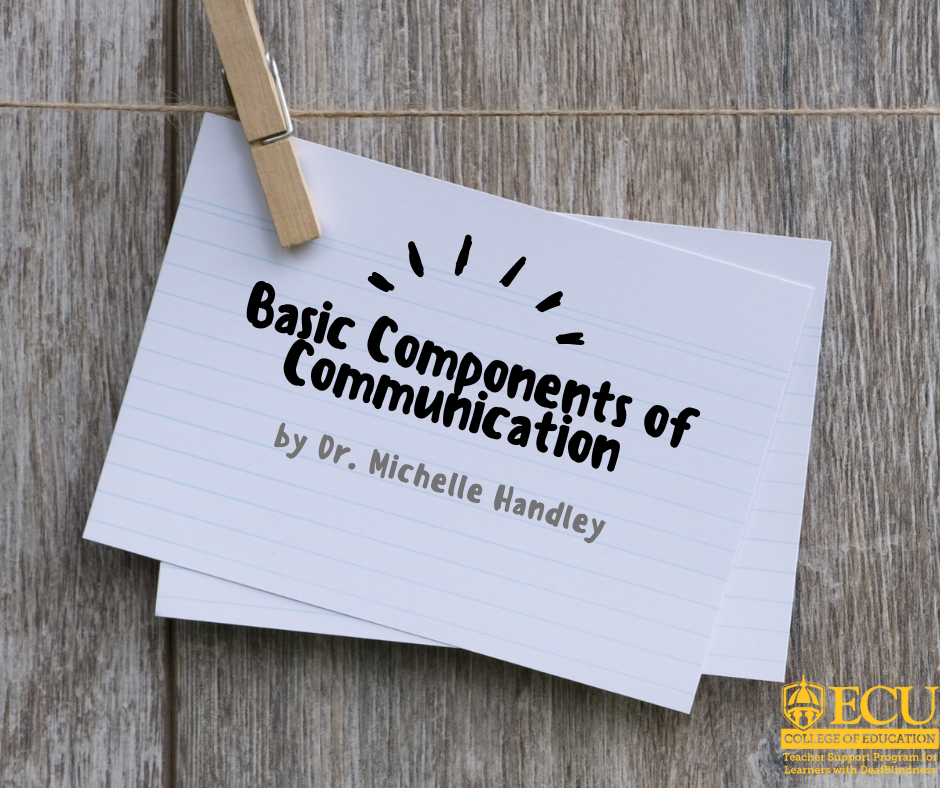By Dr. Michelle Handley
The Basic Components of a Communication Program
For a child who is deafblind, a coordinated effort by all caregivers across all environments is important to standardize communication (especially if it is non-verbal) and ensure appropriate access to communication. A communication program is a way to collect and organize this information in a way that is easily accessible to everyone who works with the child. The communication program should include a variety of factors (Belote, n.d.). After thorough data collection, including observations and feedback from multiple caregivers, the communication program for a child who is deafblind should be developed with these tenets in mind: include multiple modalities, accessible to the child, skillful to avoid overwhelming the child, interesting to the child, and practical.
Multiple Modes
Multiple modes of both expressive and receptive communication should be included in any communication program to make it easy for the child to both express herself and understand others (Crook, Miles, & Riggio, 1999). This is something that occurs naturally during typical conversations (Sacks & Zatta, 2016). Using multiple modes allows for a richer experience by enhancing or clarifying the message (e.g., facial expressions, tone of voice, manner of sign production, physical touch, etc.). Additionally, the easiest way for a child to express herself may not be the easiest way for her to understand others which will require the inclusion of different options for successful communication.
Accessible to the Child
For a communication system to be effective, it must be accessible to the child (Crook, Miles, & Riggio, 1999). A careful review of a wide range of data is the place to start. What are the effects of the child’s disabilities? Are there other physical factors regarding the child’s disability or disabilities that will affect communication? Are there areas that assistive technology could be used to increase the child’s ability to access a certain mode of communication? These are all questions to facilitate identifying ways to ensure the communication program is accessible to the child (Alsop, 1993). An example of what accessibility might look like for a child who has no residual hearing is that sign language through the air may be sufficient for her to communicate expressively, but she may require the addition of touch for the reception of sign language.
Be Skillful to Avoid Overwhelming the Child
For many children who are deafblind, active attention is required to access communication, no matter the methods being used. Mental and physical energy must be expended to access the communication, and the usable sensory abilities are taxed. This can cause concentration fatigue and overstimulation and should be considered in communication and instruction. Choosing modes of communication that are easiest for the child will help reduce the amount of fatigue a child experiences and will also allow for the energy the child uses to be more effective (Crook, Miles, & Riggio, 1999).
Interesting to the Child
Ensuring that the mode of communication is interesting to the child is a factor that will help to mediate concentration fatigue, and increase motivation and attention (Crook, C., Miles, B., & Riggio, M., 1999). If the communication modes selected for use in the program are too difficult or do not bring joy to a child, then there is a risk that the child may shut down or resist the interactions. An example might be that a child who has residual hearing is forced to use auditory communication; however, it requires a higher level of concentration than sign language (which is also accessible) and interferes with the child’s focus on the message. Adding sign language to the program might increase the child’s ability to access the message in a less taxing way which leads to a more enjoyable experience which leads to motivation to do it again which leads to development. Another example might be that a child’s communication program includes a lot of touch cues or haptics despite having visual acuity for sign language within 12 inches. This could be overstimulating to the child and lead to undesired behavioral expressions.
Practical
The modes of communication in a child’s program should be practical, which means that they are available to use throughout the day across environments and are understood by a wide range of people (Crook, Miles, & Riggio, 1999). It does not facilitate the child’s interactions, development, or communication rights (see Communication Bill of Rights at www.asha.org/njc) if only one or a few people can understand the mode or if the mode only working with certain equipment in certain environments (e.g., picture exchange systems). Learning and development in general, but in particular communication and language, are supported and accelerated when individuals are enabled to engage with a variety of speakers in a variety of environments as it broadens their experiences (Sacks & Zatta, n.d.).
References
Alsop, L. (Ed.). (1993). Communication. In A Resource Manual for Understanding and Interacting with Infants, Toddlers, and Preschool-Age Children with Deaf-Blindness, (pp. 59-68). Downs Printing.
Belote, M. (n.d.). How to Create a Communication Dictionary. California Deaf-Blind Services. https://cdbs.webnode.com/_files/200000135-b4039b5086/25CommDictionary.pdf
Crook, C., Miles, B., & Riggio, M. (1999). Selection of communication modes. In B. Miles & M. Riggio (Eds.) Remarkable conversations: A guide to developing meaningful communication with children and young adults who are deafblind (pp. 124-145). Perkins School for the Blind.
Sacks, S. Z., & Zatta, M. C. (2016). Keys to Educational Success: Teaching Students with Visual Impairment and Multiple Disabilities. American Printing House for the Blind.

